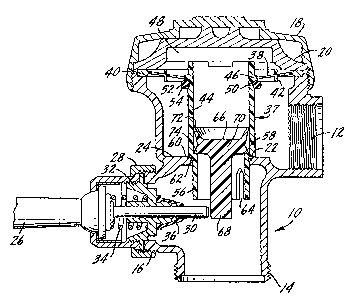Une partie des informations de ce site Web a été fournie par des sources externes. Le gouvernement du Canada n'assume aucune responsabilité concernant la précision, l'actualité ou la fiabilité des informations fournies par les sources externes. Les utilisateurs qui désirent employer cette information devraient consulter directement la source des informations. Le contenu fourni par les sources externes n'est pas assujetti aux exigences sur les langues officielles, la protection des renseignements personnels et l'accessibilité.
L'apparition de différences dans le texte et l'image des Revendications et de l'Abrégé dépend du moment auquel le document est publié. Les textes des Revendications et de l'Abrégé sont affichés :
| (12) Brevet: | (11) CA 1316898 |
|---|---|
| (21) Numéro de la demande: | 1316898 |
| (54) Titre français: | ROBINET DE CHASSE |
| (54) Titre anglais: | FLUSHOMETER RELIEF VALVE |
| Statut: | Périmé et au-delà du délai pour l’annulation |
| (51) Classification internationale des brevets (CIB): |
|
|---|---|
| (72) Inventeurs : |
|
| (73) Titulaires : |
|
| (71) Demandeurs : |
|
| (74) Agent: | RICHES, MCKENZIE & HERBERT LLP |
| (74) Co-agent: | |
| (45) Délivré: | 1993-04-27 |
| (22) Date de dépôt: | 1989-07-13 |
| Licence disponible: | S.O. |
| Cédé au domaine public: | S.O. |
| (25) Langue des documents déposés: | Anglais |
| Traité de coopération en matière de brevets (PCT): | Non |
|---|
| (30) Données de priorité de la demande: | ||||||
|---|---|---|---|---|---|---|
|
IMPROVEMENTS IN FLUSHOMETER RELIEF VALVE
Abstract of the Disclosure
This invention relates to a flexible diaphragm assem-
bly for use in a flush valve having a hollow body, an inlet, an
outlet, a valve seat formed in the body between the inlet and
outlet, and an operating handle assembly. The diaphragm assem-
bly includes a diaphragm adapted to be peripherally attached to
the flush valve body and a barrel integral with the diaphragm.
The barrel has a seal member on its exterior positioned for
sealing engagement with the body valve seat. There is an annu-
lar valve seat on the interior of the barrel and a relief valve
is positioned within the barrel and has a seat portion positioned
to close upon the barrel valve seat. The relief valve has an
annular flexible lip in contact with the interior of the barrel
and spaced from the relief valve seat portion. The relief valve
further has a stem extending outwardly from the barrel and
positioned for contact by the flush valve handle assembly.
Note : Les revendications sont présentées dans la langue officielle dans laquelle elles ont été soumises.
Note : Les descriptions sont présentées dans la langue officielle dans laquelle elles ont été soumises.

2024-08-01 : Dans le cadre de la transition vers les Brevets de nouvelle génération (BNG), la base de données sur les brevets canadiens (BDBC) contient désormais un Historique d'événement plus détaillé, qui reproduit le Journal des événements de notre nouvelle solution interne.
Veuillez noter que les événements débutant par « Inactive : » se réfèrent à des événements qui ne sont plus utilisés dans notre nouvelle solution interne.
Pour une meilleure compréhension de l'état de la demande ou brevet qui figure sur cette page, la rubrique Mise en garde , et les descriptions de Brevet , Historique d'événement , Taxes périodiques et Historique des paiements devraient être consultées.
| Description | Date |
|---|---|
| Inactive : CIB de MCD | 2006-03-11 |
| Inactive : Demande ad hoc documentée | 1996-04-27 |
| Le délai pour l'annulation est expiré | 1995-10-29 |
| Lettre envoyée | 1995-04-27 |
| Accordé par délivrance | 1993-04-27 |
Il n'y a pas d'historique d'abandonnement
Les titulaires actuels et antérieures au dossier sont affichés en ordre alphabétique.
| Titulaires actuels au dossier |
|---|
| SLOAN VALVE COMPANY |
| Titulaires antérieures au dossier |
|---|
| JOHN F. WHITESIDE |